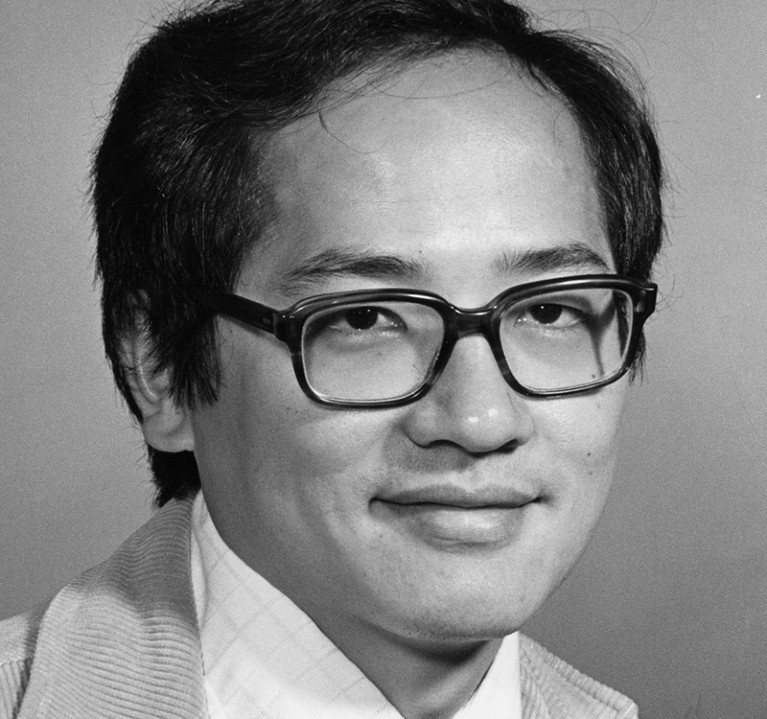
Credit: AIP Emilio Segrè Visual Archives, Physics Today Collection
The Chinese American astrophysicist Frank Hsia-San Shu made seminal contributions to the understanding of galaxies and star formation, leaving a legacy of scientific work characterized by originality and deep insight. He wrote two widely consulted textbooks, and, later in life, embarked on a second career investigating energy technologies to help combat the climate crisis. For his lifelong contributions to theoretical astrophysics, in 2009 he was awarded the Shaw Prize in astronomy — often described as the ‘Nobel of the East’ — and the Catherine Wolfe Bruce Gold Medal from the Astronomical Society of the Pacific. He died at his home in California on 22 April, aged 79.
Shu was born in 1943 in the southern Chinese city of Kunming, a refuge for intellectuals during the Second World War, owing in part to the evacuation of many universities to the city. He emigrated to the United States at the age of six when his father, the mathematician and engineer Shien-Siu Shu, joined the mathematics faculty at Purdue University in West Lafayette, Indiana. Growing up in the Midwest, he fervently pursued interests in maths and physics. He was admitted to the Massachusetts Institute of Technology in Cambridge, as one of its youngest undergraduate students in physics, and graduated in 1963.
JWST spots planetary building blocks in a surprising galaxy
At MIT, Shu began working with his mentor Chia-Chiao Lin on the dynamics of disk galaxies. This collaboration continued at Harvard University, also in Cambridge, where Shu received his PhD in 1968. Using wave-mechanic methods, Shu and Lin postulated that the spiral arms observed in disk galaxies were a wave phenomenon consisting of spiral patterns propagating through the fluid medium of stars and gas. How these patterns became amplified to their huge size remains a matter of debate, but ‘density-wave theory’ has allowed predictions of spiral-galaxy properties to be derived from first principles. It has also been used to study the gravitational stability and structure of many astrophysical objects, including galactic disks, binary stars, planet-forming disks orbiting young stars and the rings of Saturn.
Shu’s work was motivated by fundamental theoretical issues. He paid special attention to stars not just as points of mass, but as points of light. He was always interested in how they formed, looking at massive OB stars, which light up the spiral structure of disk galaxies viewed at optical and ultraviolet wavelengths. At Stony Brook University in New York, where Shu moved after his PhD, he led a team that showed how shocks induced by density waves could compress a diffuse stellar medium into a higher-density phase of star-forming giant molecular clouds. In collaboration with radio astronomers at the University of Groningen in the Netherlands, Shu provided further evidence for the density-wave theory.
After joining the faculty at University of California, Berkeley, in 1973, Shu shifted his attention to the formation of individual stars, the subject of his most influential contribution. Although molecular clouds had been identified as the birth sites of new stars, and the general picture of star formation through the collapse of material under its own gravity had been considered, few specific details were known. Shu and his collaborators had to address how nature overcomes the barriers to gravitational collapse, such as angular momentum and ambient magnetic fields.
Black-hole image reveals details of turmoil around the abyss
The paradigm that emerged was the now-standard ‘four-phase’ picture: the formation of cores of higher density in a molecular cloud; their subsequent dynamic collapse; an unexpected (but observable) phase in which strong winds of gas flow out of the still-forming protostar; and the emergence of stars accompanied by planet-forming disks. This framework closely linked theory and observations, and was bolstered further by independent developments, such as the idea that once-radioactive relics found in the most primitive meteorites might originally have been the products of ancient solar flares.
Although some of Shu’s theoretical hypotheses remain controversial, he never hesitated to tackle unsettled fundamental concepts and to explore innovative explanations of the most striking observations. He was also a prolific and lucid writer. In addition to many highly cited papers, Shu authored the universally adopted introductory textbook The Physical Universe (1982) and the two-volume graduate textbook The Physics of Astrophysics (1991–92).
Shu served as the president of the American Astronomical Society from 1994 to 1996. He engaged with a burgeoning astronomical-research community in Taiwan, leading efforts towards the launch of the Institute of Astronomy and Astrophysics, part of the research institute Academia Sinica based in Taipei. In 2002, he became president of National Tsing Hua University in Hsinchu, Taiwan, following in the footsteps of his father, who had held that position from 1970 to 1975.
Shu returned to the United States in 2006 to the University of California, San Diego, where he became professor emeritus in 2009. For the past dozen years, his concern about the climate crisis led him to study the use of molten-salt reactors to generate energy from nuclear waste and to convert waste biomass into inert products that can be sequestered, removing carbon from the atmosphere. He was also writing an undergraduate textbook called The Story of Science, which was to recount how science has underpinned human progress, and the lessons that holds for addressing climate change. That book remains unfinished, but Shu’s own place in the story of science is assured.

 JWST spots planetary building blocks in a surprising galaxy
JWST spots planetary building blocks in a surprising galaxy
 Black-hole image reveals details of turmoil around the abyss
Black-hole image reveals details of turmoil around the abyss
 The mass distribution of newborn stars depends on age and amount of metal
The mass distribution of newborn stars depends on age and amount of metal
 Frank Drake (1930–2022)
Frank Drake (1930–2022)








